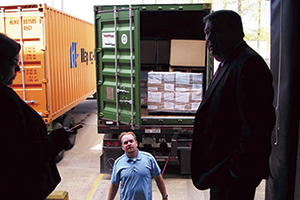Senior Reporter
Driver Coercion Rule Issued

Federal regulators last week issued a final rule that prohibits fleets as well as shippers and brokers from coercing truck drivers to violate hours-of-service and other safety regulations.
The rule was published in the Federal Register on Nov. 30 and goes into effect Jan. 29.
In the rule, developed in response to a mandate included in the 2012 MAP-21 transportation law, violators could face a fine of $16,000 per violation or, in extreme cases, loss of operating authority.
“Economic pressure in the motor carrier industry affects commercial drivers in ways that can adversely affect safety,” the rule said. “For years, drivers have voiced concerns that other parties in the logistics chain are frequently indifferent to the operational limits imposed on them by federal regulations.”
Transportation Secretary Anthony Foxx said: “This rule enables us to take enforcement action against anyone in the transportation chain who knowingly and recklessly jeopardizes the safety of the driver and of the motoring public.”
The new rule specifically notes that coercion can include not only forcing a driver to stay on the road after his maximum hours are used but also commercial driver license regulations, drug and alcohol testing rules and hazardous materials regulations.
“Other forms of coercion can occur when carriers order drivers to haul their freight using trucks with deficiencies or to drive before receiving a negative drug test result,” said Duane DeBruyne, spokesman for the Federal Motor Carrier Safety Administration.
The rule generally puts the onus on drivers, who must communicate to their employers that they believe they are being coerced to do something unsafe or in violation of a regulation. It requires drivers to report allegations of coercion within 90 days.
The agency said it implemented the rule after hearing from commercial drivers who said they were pressured to violate federal safety regulations with implicit or explicit threats of job termination, denial of subsequent trips or loads, reduced pay, forfeiture of favorable work hours or transportation jobs and other direct retaliation.
Norita Taylor, a spokeswoman for the Owner-Operator Independent Drivers Association, told TRANSPORT TOPICS that her organization generally views the rule positively as “a step in the right direction.”
“We look forward to seeing how it will be enforced and hope that more light is shed on the issue of drivers bearing the brunt of responsibility for the entire supply chain’s decisions,” Taylor said.
Bruce Carlton, CEO of the National Industrial Transportation League, a shipper group, said he is convinced the agency gave weight to comments made in response to last year’s proposed coercion rule by more precisely defining when coercion takes place.
“We would rather not have the rule on the books,” Carlton told TT. “We still believe there may be opportunities for abuse in ‘he said, she said’ types of cases.”
Carlton added, “But I was very pleased that they clarified that if a shipper is unhappy with service and says ‘we’re done with our relationship,’ that is not coercion. It’s a business decision.”
Richard Pianka, deputy general counsel for American Trucking Associations, said ATA supports the rule’s safety objectives. “Some of the definitions in the rule are pretty vague, and the burden of proof is pretty low,” Pianka said. “So we do have some concerns that there are avenues for abuse.”
Prasad Sharma, a partner at the law firm Scopelitis, Garvin, Light, Hanson & Feary, said that the rule’s “vagueness” is a concern among some truckers.
“It can be used and abused by drivers to game the system,” said Sharma, former general counsel at ATA. “I think there is some concern about how carriers need to train their dispatchers to interact with drivers, particularly when a driver raises anything that could be considered an objection.”
FMCSA said there is evidence to support the existence of coercion in the trucking industry.
For example, from 2009 to 2012, the Occupational Safety and Health Administration determined that 253 whistle¬blower complaints from commercial vehicle drivers had merit.
Last year, OSHA and FMCSA signed a memo of understanding to cooperate in future coercion investigations.
“I think it’s a step in the right direction in terms of clarifying the role of the broker and the potential of a coercion case,” said Chris Burroughs, senior government affairs manager for the Transportation Intermediaries Association, “but we still have concerns with it and will keep a close eye on how the agency enforces it.”


